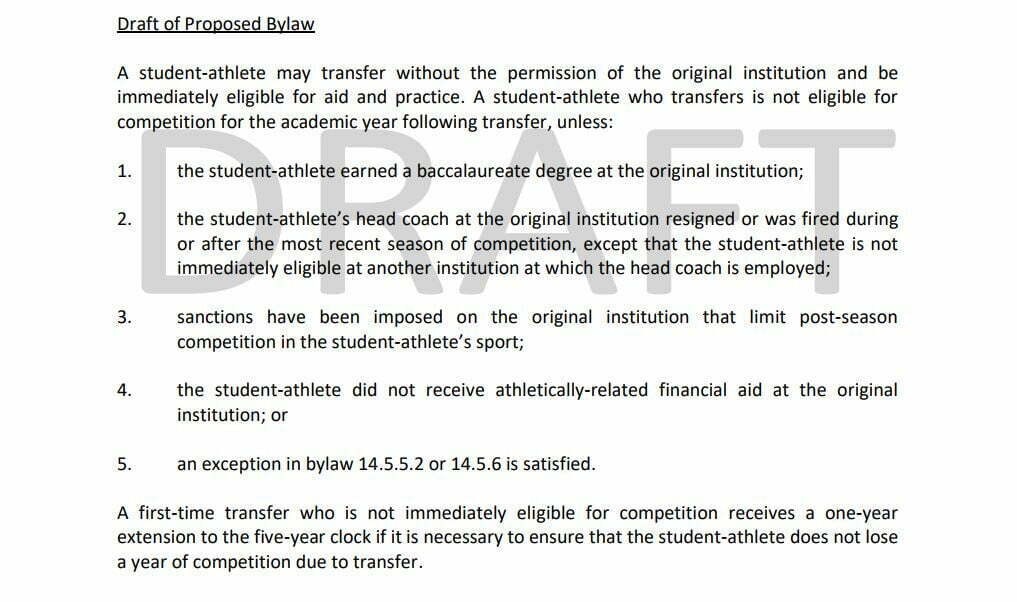Football
How a Proposed NCAA Transfer Rule Could Change the Landscape of College Football

There appears to be a change on the horizon that could cause a seismic shift in the landscape of college football.
Imagine that when the yearly college coaching carousel begins to spin, scholarship athletes would be open to transfer with immediate eligibility and with few restrictions to whichever school would take them, when his or her head coach left.
In a world where most schools are either ushering coaches out every four years or have become stepping stones themselves, that ability for a player to end his commitment to a school once that school has ended its commitment to his coach (or vice versa) is only fair.
That’s the message of many, including the Division I Transfer Working Group which was sanctioned by the Division I Board of Directors and the Presidential Forum to study the NCAA’s vast, controversial and sometimes puzzling transfer rules, and to try to find improvements that could be made.
There are a couple of proposals out there and the latest one that seems to be gaining momentum originated from two Big 12 schools. If adopted, it could change the face of college sports and football specifically.
That proposal, which you can read here, comes from Jeremy Counselor, a professor of law at Baylor University and Tim Day a professor of molecular pharmacology at Iowa State. Each is a faculty athletic representative at his respective school.
Here’s a look at some of the particulars of the proposal.

It would lift transfer restrictions for scholarship athletes in sports like football when their head coach has either been fired or has moved on to another job. Currently, a player would have to sit out a year at his new school just like any traditional transfer.
One catch is that a student athlete would not be permitted to immediately follow his coach to their new school. This stymies a head coach’s ability to use current talent as a sales pitch at his new job and conserves some competitive balance.
So when Art Briles was fired two years ago, if KD Cannon wanted to come bolster Oklahoma State’s passing attack, he could. Jarrett Stidham wouldn’t have had to sit out a year at Auburn because he wanted to leave a school that was mired in controversy stemming from things he was not a part of.
It would also allow for an immediate transfer and eligibility of an athlete if sanctions had been placed on the school like what happened with Ole Miss football. Student athletes, who have a limited number of years of eligibility would be able to get the most of those and their academic careers where they choose.
Point No. 4 would eliminate the Baker Mayfield case when he, as a non-scholarship athlete, was made to sit out one year after transferring to in-conference rival Oklahoma. Mayfield was given that extra year by the Big 12 but imagine if that was in place already. He would have been out of Mike Gundy’s unconventional style of hair a year earlier.
This proposal would also work to make things more equal across the board by adding the “year of residency” to all sports during a traditional transfer. Currently only football, men’s and women’s basketball, baseball and hockey require an athlete to sit out for a year.
It would essentially take the control of transfer decisions out of the hands of the school and place it into the hands of student athletes. No coaches blocking transfers. No having to seek permission from school A before qualifying for financial aid from school B. And any student who transfers “traditionally” and has to sit out would receive that additional year of eligibility on the back side.
Tyron Johnson transferred from LSU to Oklahoma State after his freshman season. Since Les Miles was fired following his first year in Baton Rouge, under this current proposal Johnson could have played immediately for OSU in 2016.
As it stands, he had to sit out a year in Stillwater and lost a year of eligibility. Since Tyron did not redshirt for Les Miles’ Tiger team, he basically used 2016 as that redshirt year. But had he already used a RS year, he’d just be short on time and luck.
Proposals like this have many fearful of a “free agency” in college football. It would allow Tylan Wallace to say, “I’m not getting the targets I want at OSU” and he could transfer to Texas Tech, like tomorrow. While he would have to sit a year at his new school, he would not lose any eligibility and Mike Gundy wouldn’t have a thing to say about it.
That's fearmongering nonsense. Penn State had 15 total players transfer after one of the worst scandals in CFB history https://t.co/WhPeLtS6jN
— David Ubben (@davidubben) January 30, 2018
This is just a proposal (though it’s gaining traction) and nothing has been decided as of yet. But be sure that change is coming and it’s going to shift more power into the hands of student-athletes.

-

 Hoops5 days ago
Hoops5 days agoReport: Steve Lutz Hiring George Mason’s Mike Ekanem as Assistant Coach
-

 Softball4 days ago
Softball4 days ago‘We All Love Her to Death’: Cowgirls Will See Familiar Face This Weekend in Kelly Maxwell
-

 Football4 days ago
Football4 days agoThree-Star Tight End Jordan Vyborny Commits to Oklahoma State
-

 Football5 days ago
Football5 days agoSpring Football: OSU Returns Experience at Corner as Cowboys Look to Shore Up Pass Defense






